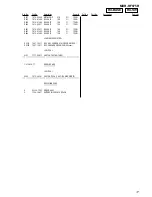
2
MDR-RF975R
This section is extracted from
instruction manual.
Flexible Circuit Board Repairing
• Keep the temperature of soldering iron around 270
°
C
during repairing.
• Do not touch the soldering iron on the same conductor of the
circuit board (within 3 times).
• Be careful not to apply force on the conductor when soldering
or unsoldering.
Notes on chip component replacement
• Never reuse a disconnected chip component.
• Notice that the minus side of a tantalum capacitor may be
damaged by heat.
SECTION 1
GENERAL
Auto power on/off function
When you remove the headphones from your
head, the power turns off automatically. Do not
allow the self adjusting band to be pulled up,
otherwise the headphones will be switched on.
The power turns on.
5
Turn up the volume to a moderate level
with the VOL control.
Press the TUNING button briefly for
automatic tuning of the headphones.
If you do not receive a clear audio signal,
press it again.
Try the above steps 3 and 5 until the
receiving performance becomes better.
TUNING
button
VOL control
TABLE OF CONTENTS
Specifications ............................................................................ 1
1.
GENERAL ......................................................................... 2
2. DISASSEMBLY
2-1. Driver (R Side), RX-BASE Board ........................... 3
2-2. SW Board, Hanger (R) ............................................. 4
2-3. Holder (R) ................................................................. 4
2-4. Driver (L Side) .......................................................... 5
2-5. Hanger (L) ................................................................ 6
2-6. Holder (L) ................................................................. 6
3. ELECTRICAL ADJUSTMENTS
3-1. Free Run Frequency Check and Adjustments ........... 7
3-2. Receive Frequency Check and Adjustments ............ 7
3-3. Carrier Modulation Check ........................................ 7
3-4. Expander Output Check ............................................ 7
3-5. Separation Check ...................................................... 7
4. DIAGRAMS
4-1. Block Diagrams ....................................................... 11
4-2. Schematic Diagram ................................................. 12
4-3. Printed Wiring Board .............................................. 13
5. XPLODEDVIEWS
....................................................... 14
6. ELECTRICAL PARTSLIST
..................................... 15



































